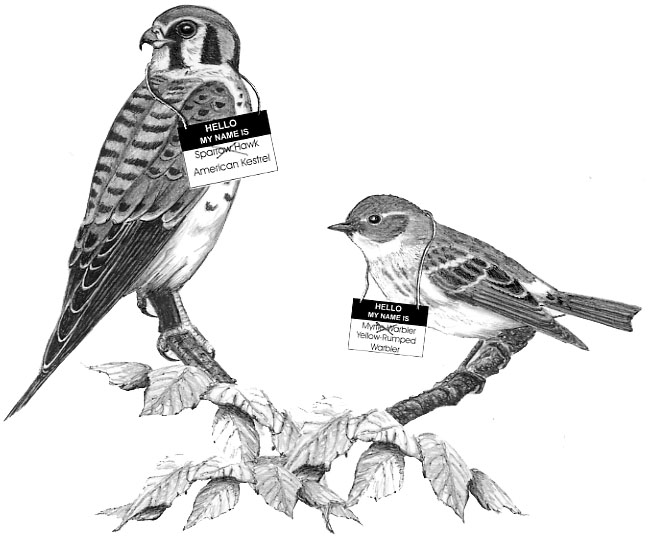
Dear Bird Folks,
As I was watching a Yellow-rumped Warbler eating at my suet feeder I started thinking about bird names. Why was the Sparrow Hawk’s name changed to American Kestrel? They still eat sparrows. Who decides that a name should be changed and why? Back to the warbler. The yellow-rump used to be called “Myrtle Warbler” until somebody changed it. How would you like it if your sister’s name was Myrtle and all of a sudden people started calling her yellow-rump?
– Gordon, Dennis, MA
Take a deep breath, Gordo,
Most people get pushed over the edge from watching sporting events or political debates. Your trigger point seems to be watching birds eating suet. In the space of a few sentences you went from enjoying feeder birds to freaking out about their names and then somehow got worked up about my sister and her rump. How did that happen? You may want to lay off suet feeder watching for a few days, until your blood pressure drops below 500.
The people who are responsible for most common bird names are the members of the American Ornithologists’ Union. The AOU, as us hip people call it, was started in 1883 and is dedicated to the study of birds. It is through its members tireless efforts and research that the rest of us have gained knowledge of America’s birds. But unlike bird clubs and Audubon societies, the AOU is not for the general public. Its members are mostly professional ornithologists, researchers and anyone else who looks good in khaki.
Birds typically have three categories of names. First, are the scientific or Latin names. Don’t even think about asking me to explain those. Then there are the common, or in our case, English names. Those are the names you and I use to identify one bird or another. When guy says he saw a “Mallard,” you know exactly what kind of bird he is talking about. At least I hope you do. In the third category we have the weird colloquial names. Those are the names that local people may call a particular bird in a particular part of its range. Only a relatively few people are familiar with any given localized name. If another guy says that he saw a “curly-tail,” you would have no idea what he is talking about. At least I hope you wouldn’t.
Because of the drake Mallard’s lovely curled tail feathers, some people call this duck “curly-tail.” How embarrassing. To bring a consistent standard to bird names, and to save the Mallard further humiliation, the AOU submits a checklist of both scientific and common names. For the most part, the names are obvious. Few people would argue with the name Blue Jay or American Goldfinch. On the other hand, many people have wondered what was going on the day the AOU accepted the name Red-bellied Woodpecker. Has anybody ever seen a red belly on that bird?_
In the case of your beloved Myrtle Warbler, Gordon, at first the myrtle part made sense. It is one of the few warblers that can survive cold weather by eating bayberry or wax-myrtle. Because of its unusual wax-myrtle diet, calling the bird Myrtle Warbler seemed like a logical choice. Then one day somebody noticed that Myrtle Warblers would regularly breed with a western bird, called Audubon’s Warbler. Uh-oh, that’s not good. At least it’s not good in terms of allowing both birds to keep their own names. Usually when two birds successfully breed they are considered to be the same species. Instead of being two different species, it was decided that the eastern Myrtle and the western Audubon’s Warbler were actually the same bird, with only a few plumage differences, depending upon their geographic location. The name Myrtle and Audubon’s had to go.
In 1973, the AOU wiped the two birds off their checklist and replaced them with one name: Yellow-rumped Warbler. I’m sure it made sense to the AOU since both birds have yellow rumps. And in a way it was the right call, but it must have been awkward for the birds themselves. Overnight, the entire world was focused on their rumps. Believe me, I know how they felt.
As for your Sparrow Hawk, Gordon, here’s the deal. I’m not going to spend a lot of time on this one because we are almost out of room and the rest of us have lives to get back to. The Sparrow Hawk’s common name was changed to American Kestrel because the bird eats few sparrows and it isn’t a hawk. That’s right. It is more closely related to the European Kestrel, which is a falcon, not a hawk. Case closed.
You are not alone on this one, Gordo. Many people still whine about the yellow-rump thing. But the change occurred nearly thirty-five years ago, so its time to get over it. Although I should talk, I still mourn the passing of Nehru jackets. I may never recover from that.